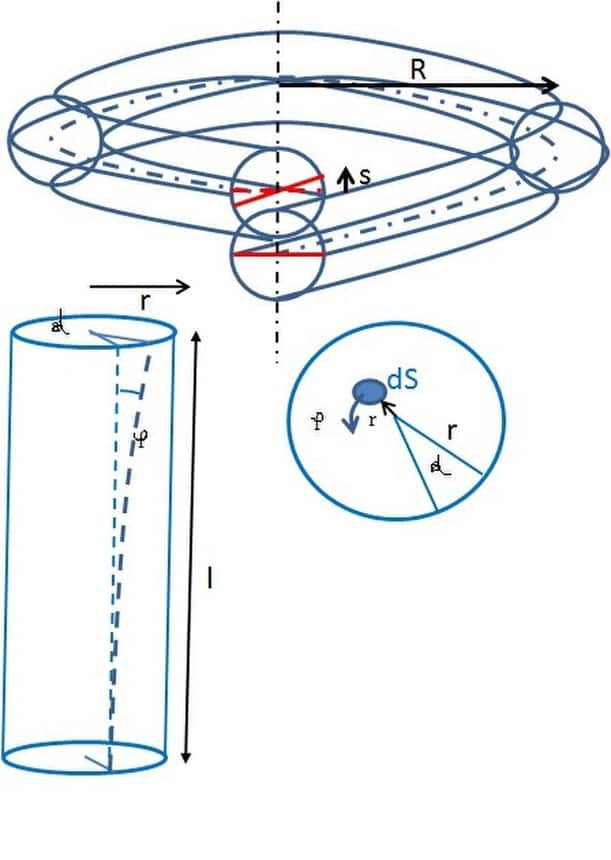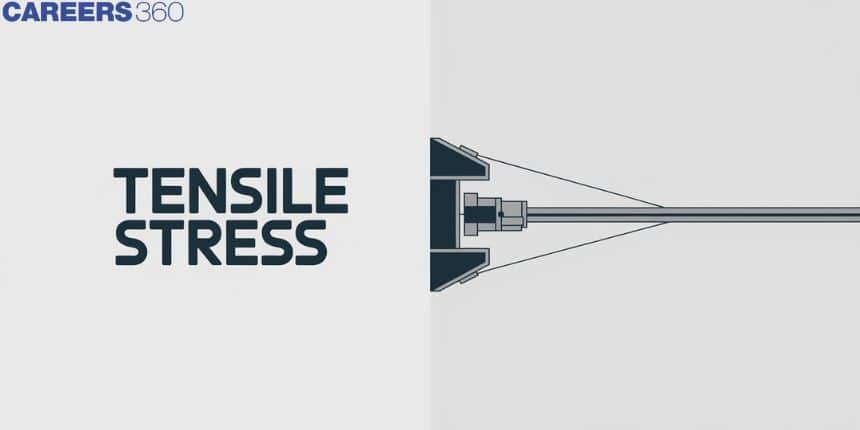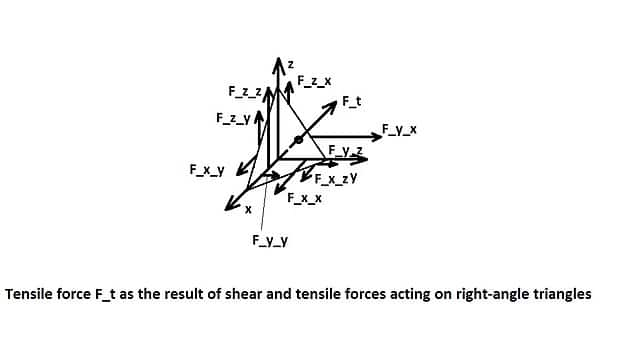1. Tensile stress is induced by what?
Tensile stress occurs when an applied load causes the material to stretch in the direction of the applied load, or in other words, when the material is pulled.
2. What happens when tensile stress is reduced?
Stress continues to rise during necking while the actual cross-sectional area decreases. When stress is estimated using the original cross-sectional area (nominal curve), however, stress appears to be reduced.
3. The tensile strength of which of the following materials is the highest?
Tungsten has the highest tensile strength of any pure metal, with a tensile strength of up to 500,000 pounds per square inch at room temperature. It possesses the maximum tensile strength, even at temperatures above 1,500°C.
4. Is tensile stress beneficial or harmful?
Tensile stress is positive in physics and engineering, while compressive stress is negative.
5. With an example, what is tensile strength?
The force necessary to pull something like a rope, wire, or a structural beam to the point of failure is known as tensile strength. A material's tensile strength is the highest amount of tensile stress it can withstand before failing, such as breaking.
6. Tensile stress can be found in a variety of places.
The force per unit area induced in the body in response to an externally applied force that tends to elongate or stretch the body is known as tensile stress.
7. What is tensile stress?
Tensile stress is the force per unit area applied to an object that tends to stretch or elongate it. It's the internal resistance of a material to external pulling forces, measured in units of pressure (e.g., N/m² or Pa).
8. How does tensile stress differ from compressive stress?
Tensile stress results from pulling forces that try to elongate an object, while compressive stress results from pushing forces that try to compress an object. Tensile stress causes expansion, while compressive stress causes contraction.
9. What is the formula for calculating tensile stress?
The formula for tensile stress is σ = F/A, where σ (sigma) is the tensile stress, F is the applied force, and A is the cross-sectional area of the object perpendicular to the force.
10. Can tensile stress be negative?
No, tensile stress is always positive. When the stress becomes negative, it's no longer tensile stress but compressive stress.
11. What are the SI units for tensile stress?
The SI unit for tensile stress is Pascal (Pa), which is equivalent to N/m² (Newton per square meter).
12. How does tensile stress relate to Hooke's Law?
Tensile stress is directly related to Hooke's Law for elastic materials. According to Hooke's Law, stress is proportional to strain within the elastic limit, and this relationship applies to tensile stress as well.
13. What is the difference between tensile stress and tensile strength?
Tensile stress is the force per unit area applied to an object, while tensile strength is the maximum tensile stress a material can withstand before failure (breaking or permanent deformation).
14. How does cross-sectional area affect tensile stress?
Tensile stress is inversely proportional to the cross-sectional area. For a given force, increasing the cross-sectional area decreases the tensile stress, and vice versa.
15. What happens to an object under tensile stress?
An object under tensile stress experiences elongation in the direction of the applied force. The amount of elongation depends on the material's properties and the magnitude of the stress.
16. Can tensile stress cause an object to break?
Yes, if the tensile stress exceeds the material's tensile strength, the object will break or undergo permanent deformation.
17. What is elastic deformation in the context of tensile stress?
Elastic deformation is the temporary change in shape or size of an object under tensile stress, where the object returns to its original form when the stress is removed, as long as the elastic limit is not exceeded.
18. What is the elastic limit in relation to tensile stress?
The elastic limit is the maximum stress a material can withstand while still returning to its original shape when the stress is removed. Beyond this limit, the material undergoes plastic deformation.
19. How does temperature affect a material's response to tensile stress?
Temperature can significantly affect a material's response to tensile stress. Generally, higher temperatures make materials more ductile and less resistant to tensile stress, while lower temperatures can make materials more brittle.
20. What is strain in the context of tensile stress?
Strain is the measure of deformation experienced by an object under stress. In the case of tensile stress, it's typically the ratio of the change in length to the original length of the object.
21. How is Young's modulus related to tensile stress?
Young's modulus is the ratio of tensile stress to tensile strain within the elastic limit. It measures a material's stiffness or resistance to elastic deformation under tensile stress.
22. What is the difference between ductile and brittle materials under tensile stress?
Ductile materials (like copper or aluminum) undergo significant plastic deformation before breaking under tensile stress. Brittle materials (like ceramics or glass) break with little or no plastic deformation.
23. How does tensile stress affect the atomic structure of a material?
Tensile stress causes atoms in a material to move farther apart, increasing interatomic distances. This can lead to changes in the material's properties and, if severe enough, can cause the material to fail.
24. What is work hardening in relation to tensile stress?
Work hardening is the strengthening of a material by plastic deformation. When a material is subjected to tensile stress beyond its elastic limit, it can become stronger and more resistant to further deformation.
25. How does the rate of applied tensile stress affect a material's response?
The rate at which tensile stress is applied can significantly affect a material's response. Rapid application of stress can cause brittle failure in materials that would otherwise deform plastically under slower stress application.
26. What is Poisson's ratio and how does it relate to tensile stress?
Poisson's ratio is the negative ratio of transverse strain to axial strain. When a material is stretched under tensile stress, it tends to contract in the directions perpendicular to the applied stress, and Poisson's ratio quantifies this effect.
27. How does tensile stress contribute to fatigue failure?
Repeated application of tensile stress, even below a material's yield strength, can lead to fatigue failure over time. This occurs due to the gradual formation and growth of microscopic cracks in the material.
28. What is stress concentration and how does it affect tensile stress?
Stress concentration refers to the localization of high stresses in certain areas of an object, often due to changes in geometry. These areas experience higher tensile stress than the average stress in the object, potentially leading to failure.
29. How do composite materials behave under tensile stress?
Composite materials often exhibit anisotropic behavior under tensile stress, meaning their response varies depending on the direction of the applied force. The overall behavior depends on the properties and arrangement of the constituent materials.
30. What is the significance of the stress-strain curve in understanding tensile stress?
The stress-strain curve provides a visual representation of a material's behavior under tensile stress. It shows the relationship between stress and strain, including the elastic region, yield point, and ultimate tensile strength.
31. How does crystal structure influence a material's response to tensile stress?
Crystal structure significantly affects a material's response to tensile stress. Materials with more slip planes (like face-centered cubic structures) tend to be more ductile, while those with fewer slip planes (like hexagonal close-packed structures) tend to be less ductile.
32. What is necking in the context of tensile stress?
Necking is the localized reduction in cross-sectional area that occurs in ductile materials under high tensile stress. It happens after the ultimate tensile strength is reached and leads to eventual fracture.
33. How does grain size affect a material's response to tensile stress?
Generally, materials with smaller grain sizes are stronger and more resistant to tensile stress. This is because grain boundaries impede the movement of dislocations, which are responsible for plastic deformation.
34. What is the difference between engineering stress and true stress?
Engineering stress is calculated using the original cross-sectional area of the material, while true stress uses the instantaneous cross-sectional area. True stress is always higher than engineering stress during plastic deformation due to necking.
35. How does tensile stress relate to the concept of resilience?
Resilience is the ability of a material to absorb energy when deformed elastically and release that energy upon unloading. It's related to the area under the stress-strain curve in the elastic region, which involves tensile stress.
36. What is the significance of the yield point in relation to tensile stress?
The yield point is the stress at which a material begins to deform plastically. It marks the transition from elastic to plastic behavior under tensile stress and is an important parameter in material selection for engineering applications.
37. How does tensile stress affect the electrical properties of materials?
Tensile stress can change a material's electrical properties by altering its atomic structure. For example, it can increase electrical resistance in metals by increasing the scattering of electrons.
38. What is creep and how is it related to tensile stress?
Creep is the tendency of a material to slowly deform permanently under constant stress, even below its yield strength. It's particularly relevant for materials under long-term tensile stress, especially at high temperatures.
39. How does tensile stress contribute to stress corrosion cracking?
Tensile stress, combined with a corrosive environment, can lead to stress corrosion cracking. The stress opens up small cracks in the material, allowing corrosive agents to penetrate and accelerate the cracking process.
40. What is the difference between isotropic and anisotropic materials in terms of tensile stress response?
Isotropic materials have the same properties in all directions, so their response to tensile stress is uniform regardless of the direction of applied force. Anisotropic materials have different properties in different directions, so their response varies based on the direction of the applied tensile stress.
41. How does tensile stress affect the magnetic properties of materials?
Tensile stress can alter the magnetic properties of materials through magnetostriction. In ferromagnetic materials, tensile stress can change the ease with which magnetic domains align, affecting the material's overall magnetic behavior.
42. What is the relationship between tensile stress and shear stress?
Tensile stress and shear stress are related through Mohr's circle. Pure tensile stress in one direction results in shear stresses at 45-degree angles to the tensile stress direction.
43. How does tensile stress contribute to the phenomenon of metal whisker growth?
Tensile stress, particularly residual stress in metal films or coatings, can contribute to the growth of metal whiskers. These are thin, hair-like protrusions that can cause short circuits in electronic components.
44. What is the role of dislocations in a material's response to tensile stress?
Dislocations are crystal defects that play a crucial role in plastic deformation under tensile stress. Their movement allows for plastic flow in crystalline materials, and their interactions with other defects and grain boundaries influence the material's strength and ductility.
45. How does tensile stress affect the optical properties of transparent materials?
Tensile stress can induce birefringence in transparent materials, causing them to become optically anisotropic. This stress-induced birefringence can be used in photoelasticity to analyze stress distributions in transparent objects.
46. What is the difference between nominal stress and true stress in tensile testing?
Nominal stress (or engineering stress) is calculated using the original cross-sectional area, while true stress uses the instantaneous cross-sectional area. True stress accounts for the reduction in cross-sectional area during deformation and is always higher than nominal stress in the plastic region.
47. How does strain rate affect a material's response to tensile stress?
Higher strain rates (faster application of tensile stress) generally result in higher yield strengths and reduced ductility. This is because there's less time for plastic deformation mechanisms to operate, leading to more brittle behavior.
48. What is the significance of the ultimate tensile strength?
The ultimate tensile strength is the maximum stress a material can withstand before failing. It's a crucial parameter in engineering design, indicating the upper limit of stress a material can handle in tension.
49. How does work hardening affect a material's response to tensile stress?
Work hardening increases a material's yield strength by increasing the density of dislocations. This makes the material more resistant to further plastic deformation under tensile stress but also reduces its ductility.
50. What is the difference between tensile toughness and tensile strength?
Tensile toughness is the ability of a material to absorb energy before fracturing, represented by the total area under the stress-strain curve. Tensile strength is the maximum stress a material can withstand before failing. A material can have high strength but low toughness, or vice versa.
51. How does tensile stress affect the thermal conductivity of materials?
Tensile stress can affect thermal conductivity by changing the material's atomic structure and phonon scattering. In metals, it generally decreases thermal conductivity by increasing electron scattering.
52. What is the role of grain boundaries in a material's response to tensile stress?
Grain boundaries act as barriers to dislocation movement, increasing a material's strength under tensile stress. However, they can also serve as sites for crack initiation and propagation, potentially reducing overall toughness.
53. How does tensile stress contribute to the martensitic transformation in some materials?
Tensile stress can induce martensitic transformation in some materials, particularly shape memory alloys. This stress-induced phase transformation can lead to significant strain and is the basis for the shape memory effect.
54. What is the relationship between tensile stress and fracture toughness?
Fracture toughness is a measure of a material's resistance to crack propagation under stress. Materials with high fracture toughness can withstand higher tensile stresses in the presence of cracks or flaws without catastrophic failure.
55. How does tensile stress affect the behavior of polymeric materials?
In polymers, tensile stress can cause molecular chains to align in the direction of the applied force, leading to strain hardening. This alignment can significantly change the material's properties, including increased strength and reduced ductility in the direction of stress.
56. What is the significance of residual stress in relation to tensile stress?
Residual stresses are internal stresses that exist within a material without external loading. They can significantly affect a material's response to applied tensile stress, either enhancing or reducing its overall strength and fatigue resistance depending on the nature and distribution of the residual stresses.




